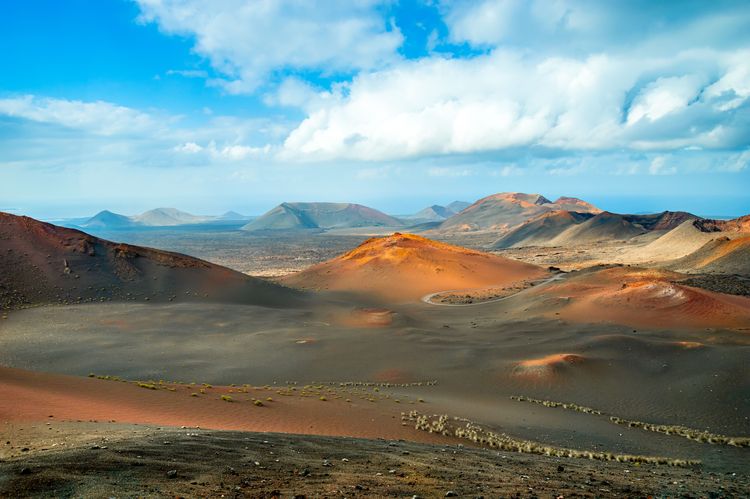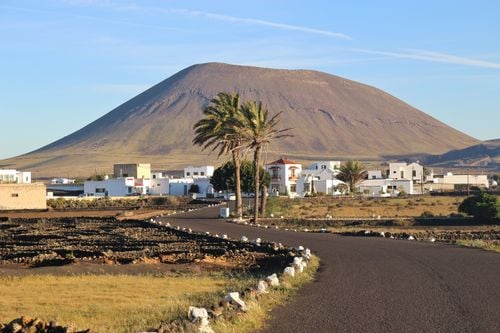After landing at Arrecife airport the evening before, we chose to spend our first night in the capital's most beautiful hotel, the5* Arrecife Gran Hotel & Spa. Even so, we didn't want to be disorientated too quickly!
Although camping in the wild is theoretically forbidden in the Canary Islands, the authorities on Lanzarote often turn a blind eye and allow tourists to explore the island's lunar landscapes in a converted van. Lanzarote is a popular destination for van enthusiasts, who whisper to each other about the best parking spots to spend the night. By the sea or in the middle of volcanoes, the sound of the waves or the absolute calm promise sweet nights and grandiose panoramas when you wake up. We're used to sleeping in hotels, but when we heard that Lanzarote is one of the safest destinations to try this kind of unusual experience, we immediately wanted to give it a try! Follow us as we take you on a 5-day road-trip around Lanzarote in a converted van!
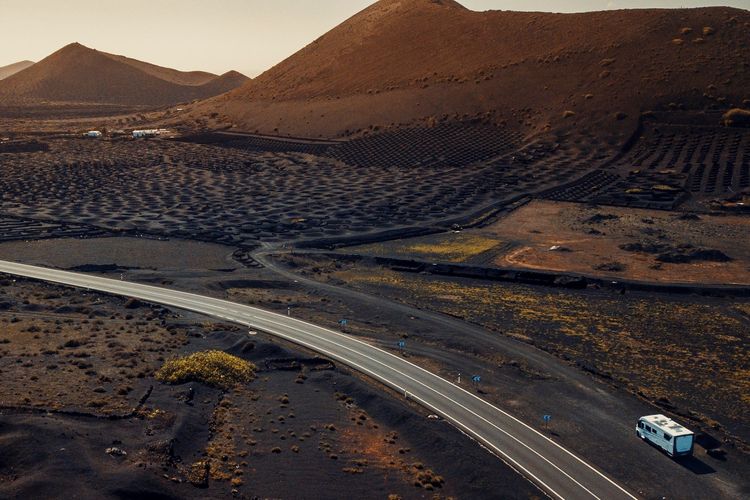
✈️ Book your plane ticket to Lanzarote
Fly to Lanzarote, where nature, culture and art come together in the most charming of combinations!Day 1: Arrecife to Yaiza along the wine route
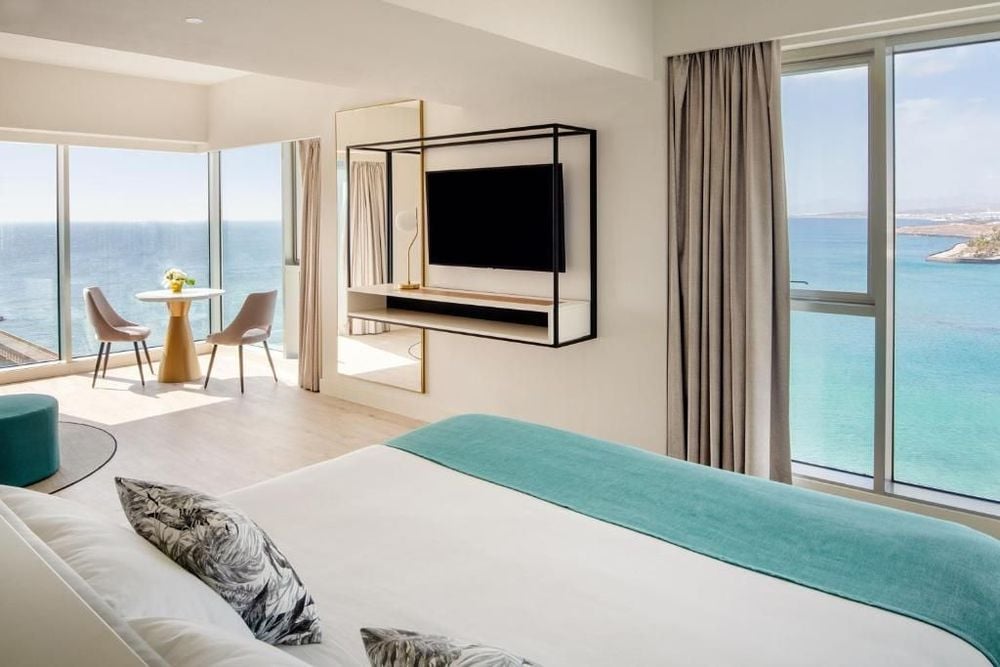 Arrecife
Arrecife
Arrecife Gran 5* Hotel & Spa
Indoor swimming pool, sea-view rooms, rooftop restaurant... You're sure to love this superb 5-star hotel in Arrecife!A restful night's sleep and breakfast on the hotel's rooftop later, we're back on the streets of Arrecife. We still had a little time before picking up our vehicle, so we took the opportunity to have a look around the town. From the seafront promenade, we pass the Castillo de San Gabriel before reaching the Charco de San Ginés and its multicoloured boats. We also wandered into the narrow streets lined with white houses with blue shutters to admire the typical architecture of the San Ginés church. Unfortunately, we won't have time to visit the MIAC, which is a real shame!
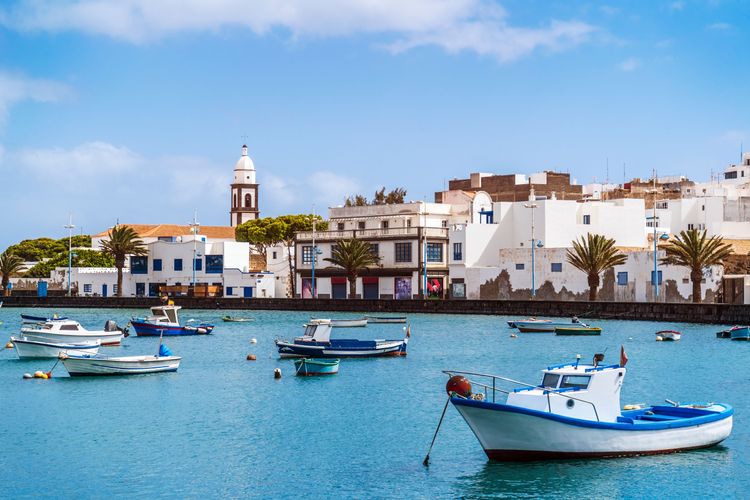
The Charco de San Ginés in Arrecife, with the San Ginés church in the background.
- © Sopotnicki / ShutterstockAfter picking up our car (which we found on Booking.com, but this one's really small, so you'll probably find something better on Yescapa, we hit the road in the direction of the César Manrique Foundation, just 10 minutes from Arrecife. This is the former home of the famous César Manrique, designed by the artist himself. Built on an ancient lava flow, the house blends into its surroundings, with some of the rooms housed directly in volcanic bubbles! The visit also provides an opportunity to learn more about the life of Lanzaroteños' most beloved personality.
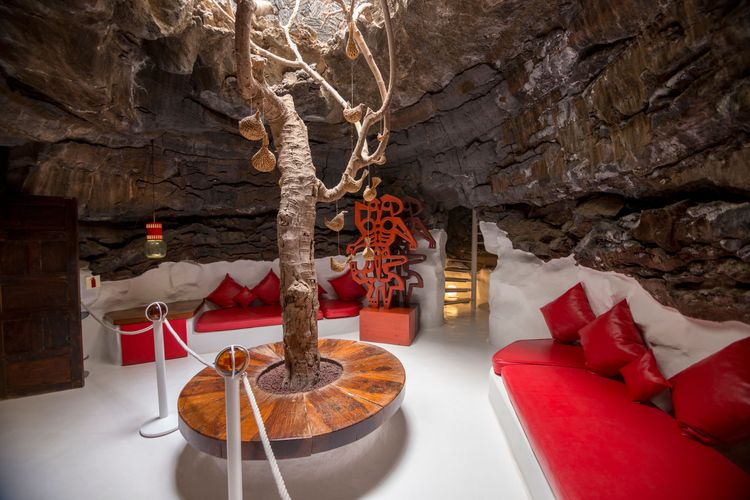
A room in the César Manrique Foundation built in a volcanic bubble.
- © Jef Wodniack / ShutterstockTime has flown and it's already time for lunch! We're heading for San Bartolomé, one of the most beautiful villages on Lanzarote. The pretty terrace of the Bar La Plaza is unfortunately full, so we fall back on the Restaurante La Barraca, where we enjoy croquetas and paella for very little money!
With our bellies full, we continued our César Manrique tour by going to the Casa Museo del Campesino, where we were greeted by the monument to Fertility. It was created by the artist fromold sailing ship water containers and various other objects. Next door, the Casa Museo del Campesino, with itstraditional Lanzarote architecture, presents the island's typical trades.
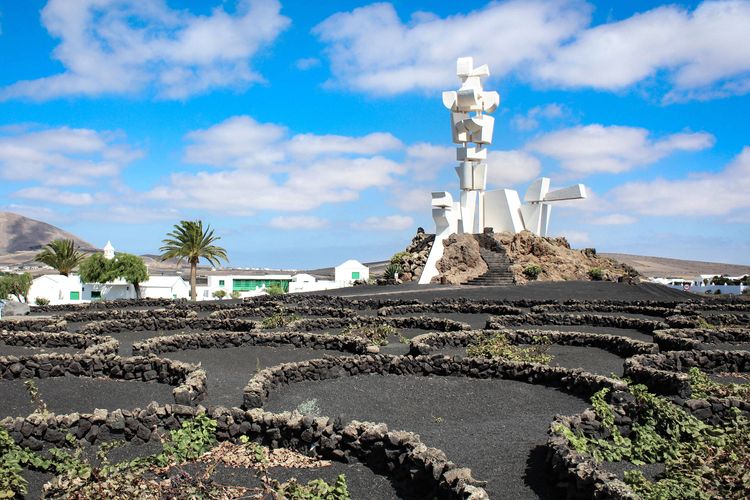
The Fertility Monument on the right and the Casa Museo del Campesino on the left.
- © MisterStock / ShutterstockCasa Museo del Campesino is located at the entrance to the Lanzarote wine route, on the LZ-30. Here, the vines grow right on the volcanic sand, protected from the wind by a low stone wall. Add to this the volcanoes in the background, and you find yourself in the midst of landscapes as beautiful as they are strange.
Bodegas are scattered along the route. We liked the bodega Rubicón, which offers inexpensive wines by the glass and a free tour of their cellar. Our favourite is the oldest bodega, El Grifo, which houses a museum on the history of wine in Lanzarote. In our opinion, the others are of little interest, apart from the bodega La Geria, which offers a great view of the vineyards.

The vineyards of La Geria on Lanzarote.
- © Sopotnicki / ShutterstockWe dine in the charming village of Yaiza at La Bodega de Santiago, where the food is a little expensive but of a high quality, and the terrace is very pleasant. Then it was time to find somewhere to sleep for our first night in a converted van! We spotted an interesting spot on park4night, a quiet spot at the end of a dirt track, in the middle of the lava sea, with the Timanfaya volcanoes as a backdrop. It's here on Google Maps (use the satellite view to find it better). It's a magnificent spot, and you can see the stars perfectly. As you lie down in the van, you know it's going to be a gentle night.
Day 2: Beaches and volcanoes
We wake up at dawn this morning to watch the sun rise over the volcanoes: trust us, it's worth it! We watch the sky lighten and nature come alive as we enjoy our breakfast. But we don't want to linger too long, as we want to get to Timanfaya National Park before it opens at 9.30am, toavoid the crowds. The road to the park already offers a taste of its natural wonders.
We would have liked to have been able to explore the park on foot, but this isn't possible without a reservation, so we'll have to make do with the bus tour. The bus takes us through some incredible landscapes that look like something out of a science fiction film, and the commentary gives us the chance to find out more about the Mountains of Fire. At the end of the tour, it was a little too early to enjoy roast chicken directly on a volcanic fault at the El Diablo restaurant, but the staff demonstrated thegeothermal activity of the area by creating geysers and burning straw on the ground.
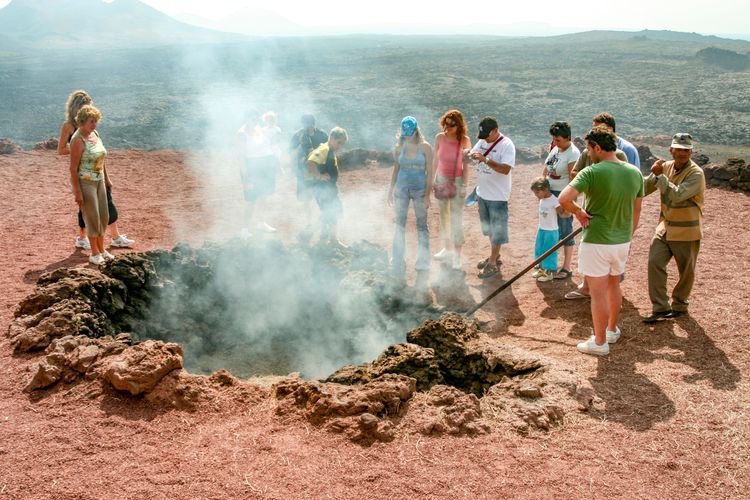
Volcanic activity in Timanfaya National Park is clearly visible.
- © travelview / ShutterstockWe're leaving Timanfaya National Park, but we're still in the mood for volcanoes! So we set off to climb the Caldera Blanca, the largest crater in the Canary Islands at 1,200 metres in diameter. We're not great walkers, so we had to take a few breaks during the ascent: we took the opportunity to admire the superb view over the ocean and the Timanfaya volcanoes. And that's just a foretaste of what awaits us at the top... In fact, it's only once we reach the summit that we realise that the crater is truly gigantic! We felt very small as we picnicked in front of this natural monster. There's no doubt about it, this is one of the best hikes on Lanzarote!
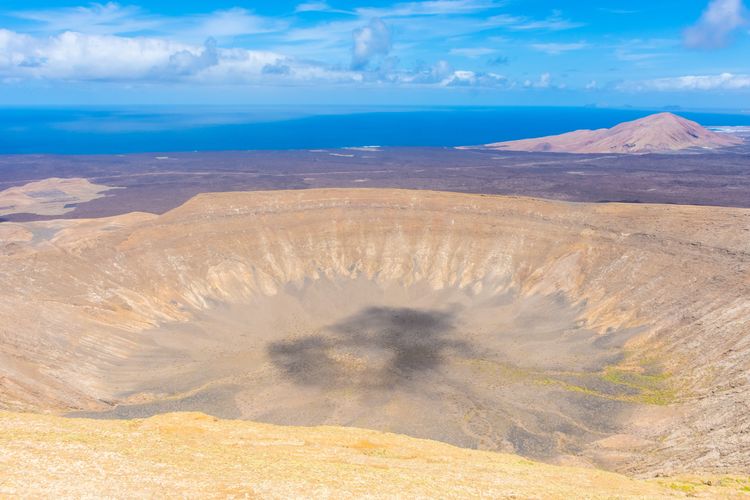
View of the crater from the summit of Caldera Blanca.
- © Stefano Zaccaria / ShutterstockAfter the effort, the comfort! What better way to recover from a hike than to bask in the sun on a heavenly beach? We chose Papagayo beach, one of the most beautiful beaches on Lanzarote. The long sandy track leading to it discourages many visitors, so it's rarely crowded. Alternating between swimming and sunbathing, we'll stay there until dusk to enjoy the sunset over the islands of Los Lobos and Fuerteventura. What a spectacle!

La plage de Papagayo à Lanzarote.
- © Josu Ozkaritz / ShutterstockFor dinner, we head for the seaside resort of Playa Blanca, whose seafront promenade is lined with restaurants. Many of them are tourist traps, but we found what we were looking for at the Restaurante Grill Volcan De Timanfaya, which, while not great food, was a treat to eat overlooking the ocean. We then headed to a spot we'd spotted during the day, next to the Janubio salt flats (it's here on Google Maps). Unlike the day before, we're not alone there, but it's a really nice spot and we fall asleep to the sound of the waves.
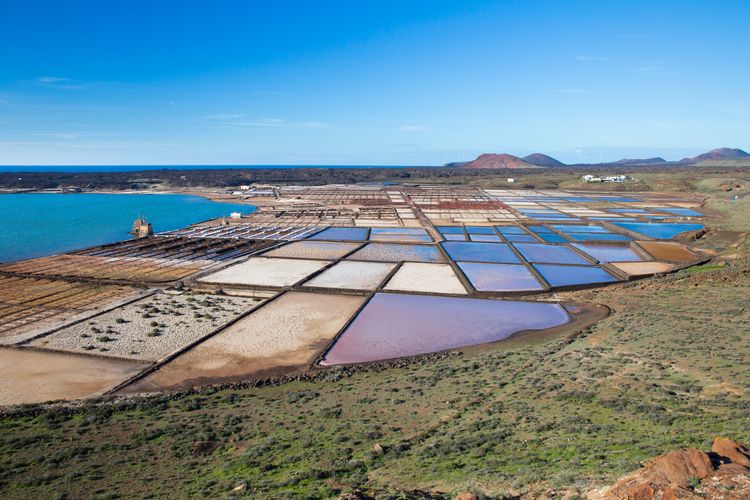
The Janubio saltworks near El Golfo.
- © NICOLA MESSANA PHOTOS / ShutterstockDay 3: El Golfo to Haría
As we're right next door, the first stop on this new day will be the Janubio salt flats. The morning light tints the shallow waters blue, purple and pink in a splendid gradation. The route then continues on to Los Hervideros, volcanic caves created by the eruptions of the 18th century, into which the waves of the Atlantic crash and crash: it's breathtaking! Finally, we reach the village of El Golfo, without missing a trip to the green lagoon, an ancient volcanic crater filled by seawater infiltration, which owes its strange colouring to the algae that have colonised the lake.

The green lagoon on Lanzarote.
- © Sybille Reuter / ShutterstockAfter our hike yesterday, we're convinced: the best way to discover Lanzarote is on foot! So here we are, on the coastal path from El Golfo, which winds along the coast through the black rocks of the lava sea. It leads to the playa del Paso, a wild beach where the foam licks the intensely black sand. Bathing is forbidden here because of the currents, but it's well worth taking a moment to gaze at the horizon. The path then leaves the coast to reach Montaña Quemada. We make the only real effort of the hike to climb to its summit, the rest being mainly flat, and are greeted by a magnificent panorama of the Atlantic and Timanfaya.
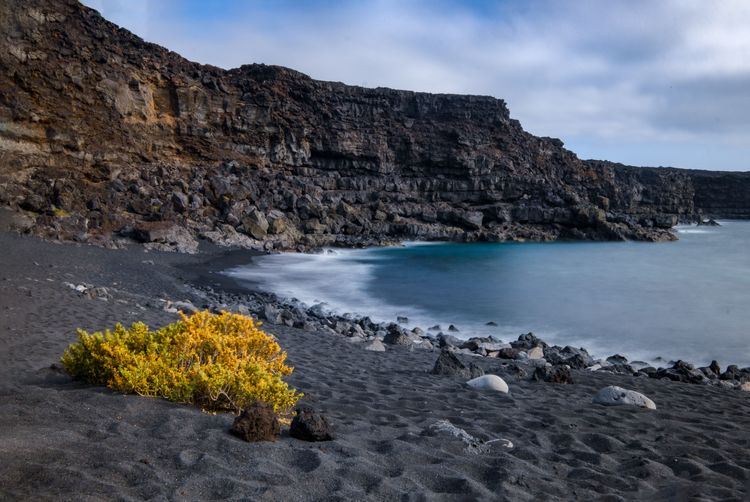
Playa del Paso on the coastal path.
- © Vesna Kriznar / ShutterstockIt's lunchtime when we return to El Golfo, and we set our sights on the Restaurante Bogavante, which offers affordable seafood specialities overlooking the ocean. We then set off for the Jardín de Cactus, one of the works of César Manrique, around fifty minutes away. In this former volcanic ash quarry, visitors can admire over 10,000 cacti of 1,450 different species, some of them several metres high! It's like taking a break from the Wild West.

The Jardín de Cactus in Lanzarote.
- © Olena Tur / ShutterstockA 15-minute drive away, Haría is a pretty village with narrow streets lined with white houses and palm trees. This is where you'll find the Casa-Museo de César Manrique, the house where the artist spent his old age until his death. Less impressive than the César Manrique Foundation, it is still well worth a visit, if only to see the painter's studio. For our part, we appreciate thepeaceful atmosphere here, which makes you want to linger by the pool or in the garden.
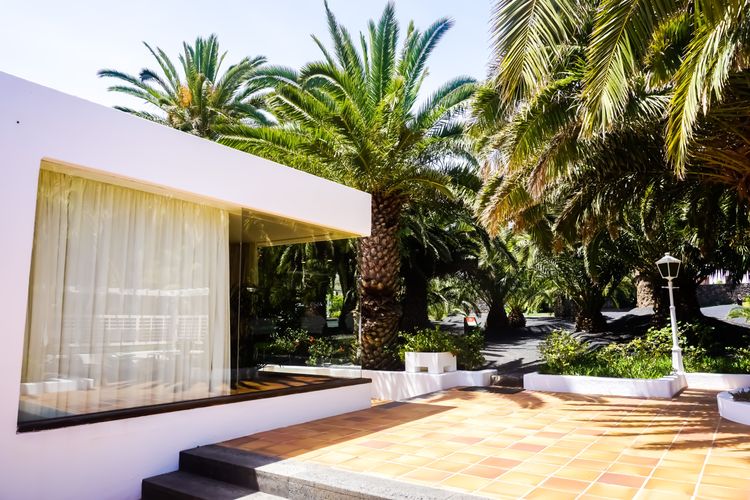
La Maison-musée César Manrique à Lanzarote.
- © Stefano_G / ShutterstockBy the time we finish the tour, the sun will soon be disappearing. So we head off to the Mirador de Guinate for an aperitif (which you'll need to take with you, as there are no bars or shops on site) with a breathtaking view of the island of La Graciosa as the sun dips behind the horizon. It's perhaps the most beautiful suns et we've ever seen! Once night had fallen, we headed back to Haría to dine at the Centro Cultural La Tegala, a really good address where we were served typical Canarian dishes with a smile!
For the night, we once again rely on park4night, thanks to which we find a lovely spot by the sea (it's here on Google Maps), close to our planned activities for the following morning. The place can't accommodate more than three or four vehicles, so it's pretty quiet and we soon fall into the arms of Morpheus, lulled by the sound of the waves.
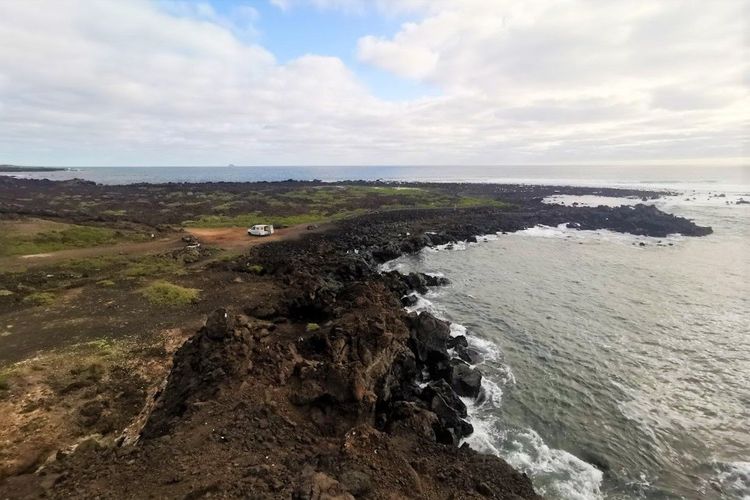
Our van parked by the sea, where we slept.
- © Sauvane Beerli / EasyvoyageDay 4: North Lanzarote and La Graciosa
We ate our breakfast overlooking the sea and headed for the Jameos del Agua, just a stone's throw away. This immense volcanic cavity, in which a natural lake has formed as a result of seawater infiltration, is home to a species of albino crab that is unique in the world! In the 1960s, César Manrique transformed it into a tourist centre where art and nature meet, adding a bar-restaurant, two concert halls, two dance floors and a seawater swimming pool. It's very beautiful, but a little expensive for what it is.
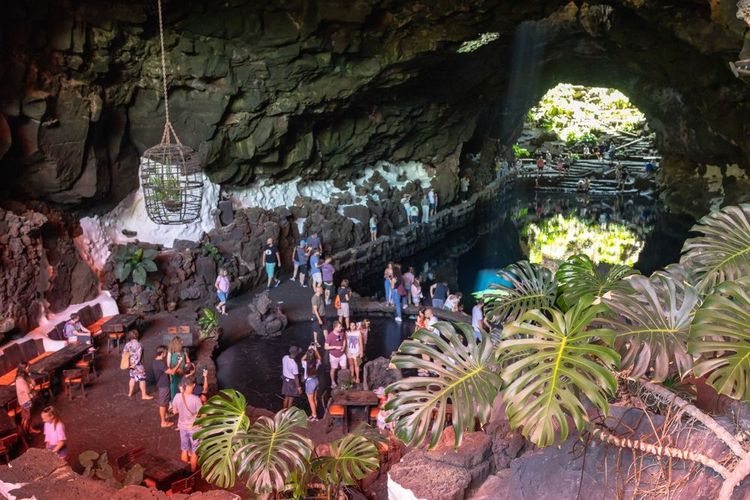
The Jameos del Agua in Lanzarote.
- © natakontur / ShutterstockAnd yes, we like to get our money's worth, and for that there's the Cueva de los Verdes! For almost an hour, a guide leads us through a kilometre-long volcanic tunnel, filling us in on the formation of the cave. In particular, we learn that the cave was created by the eruption of the La Corona volcano 4,000 years ago and that it is in fact over seven kilometres long! It plunges right down into the ocean, earning it the nickname "thetunnel of Atlantis". A surprise awaits visitors at the end of the tour, but don't expect us to tell you what it is...
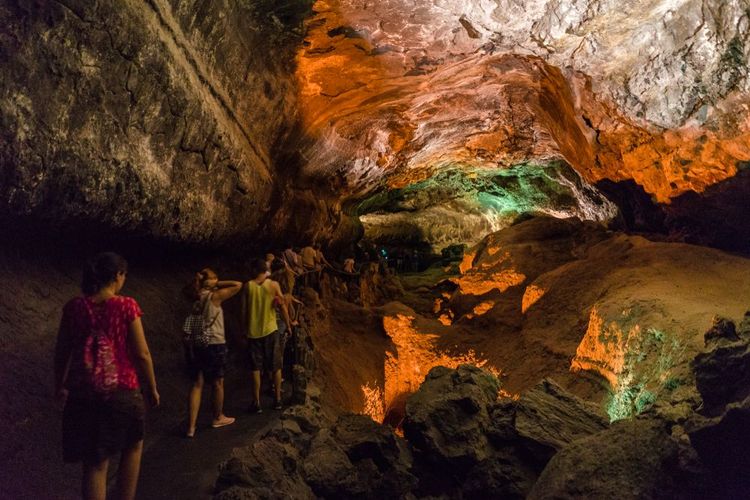
The cave of Los Verdes
- © A.Ruiz / ShutterstockAfter burying ourselves beneath the surface, let's get some height: head for the Mirador del Río, perched on the summit of Risco de Famara, at the northernmost tip of the island. From the outside, you wouldn't expect anything, but you'll be breathless when you reach the panoramic terrace. The view over the island of La Graciosa and all the shades of blue in the sky and sea leaves you breathless. The place was also designed by César Manrique, and the artist's touch is recognisable in the architectural details. The Mirador del Río café offers a selection of snacks, but we're in the mood for a real meal, so we head for the pretty coastal village of Orzola.
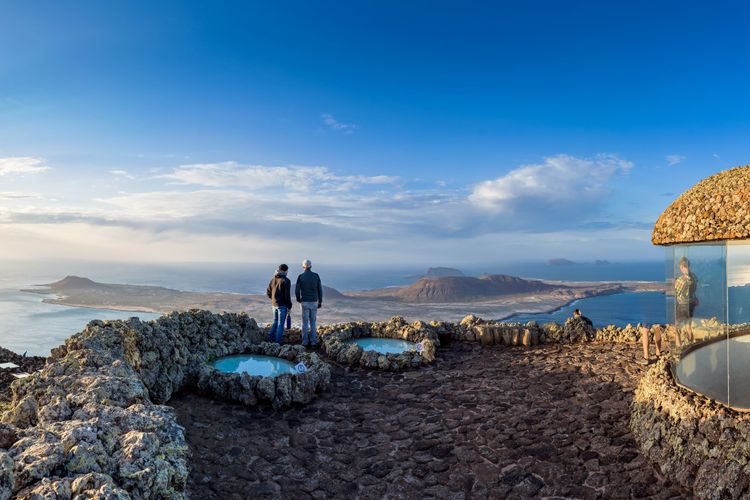
The view of the island of La Graciosa from the Mirador del Río.
- © Eddy Galeotti / ShutterstockThat's just as well, because that's where the ferry leaves for our next destination: the island of La Graciosa. Before boarding, we had lunch overlooking the sea at Restaurante Mirador El Roque, a very good address! We then hop on the ferry for a 30-minute crossing, but it's not possible to bring your car. So we left our van in Orzola and booked last-minute accommodation on Booking.com.
Once we arrive on La Graciosa, we jump in a 4x4 taxi to visit the tiny village of Pedro Barba. The village's few white huts face the stunningly calm Famara de Lanzarote cliffs. The driver then takes us to los Arcos de los Caletones, arches of volcanic rock, carved by the waves, overlooking the ocean. Finally, we reach the almost deserted beach of Las Conchas, where we lie on the golden sand waiting for the sun to set over the uninhabited islets of Montaña Clara and Alegranza. The ocean is quite rough, so we prefer not to swim there.
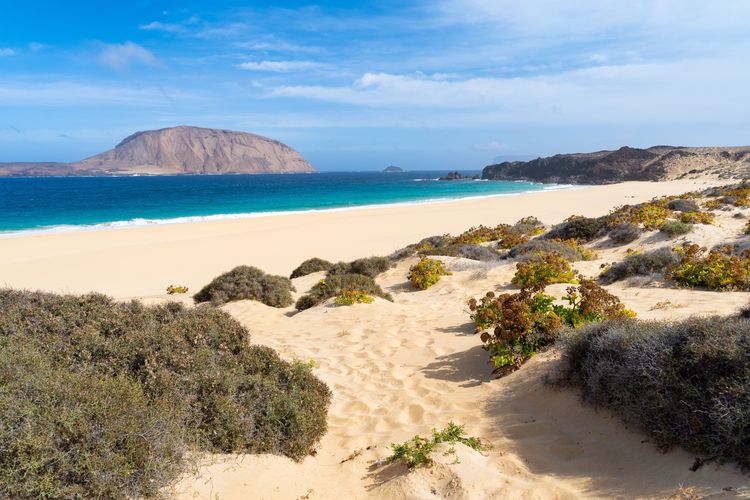
The beach Las Conchas à La Graciosa.
- © Wirestock Creators / ShutterstockAs night falls, we head back to the main village, Caleta de Sebo, where we've booked a cute flat to spend the night. But before going to bed, we dine at Restaurante El Varadero Del Puerto, where we feast on fried fish and seafood in front of the boats bobbing quietly in the harbour.
Day 5: sea, sun & vulcano
The sun rises over La Graciosa and we decide to spend a quiet morning in Caleta de Sebo. The little fishing village takes on a western feel with its sandy streets winding between small white and blue houses. We spend an hour at Playa Francesa, a few minutes' drive from the village, where we swim in the calm, crystal-clear waters. It's easy to lose track of time in these dreamy landscapes, and it's already time to get back on the ferry if we want to be back on Lanzarote by lunchtime.

The village of Caleta de Sebo à La Graciosa.
- © Sopotnicki / ShutterstockWe eat in Orzola, in the same restaurant as the day before (we told you it was a good address!), before tackling the ascent of Monte Corona. Remember Monte Corona? This is the volcano whose eruption is the origin of the Cueva de los Verdes! It's the biggest volcano on Lanzarote, but the hike to its summit isn't as gruelling as it looks. What's more, the view from the top is worth all the effort in the world: between the intense red crater and the view over the whole island, you won't be disappointed!
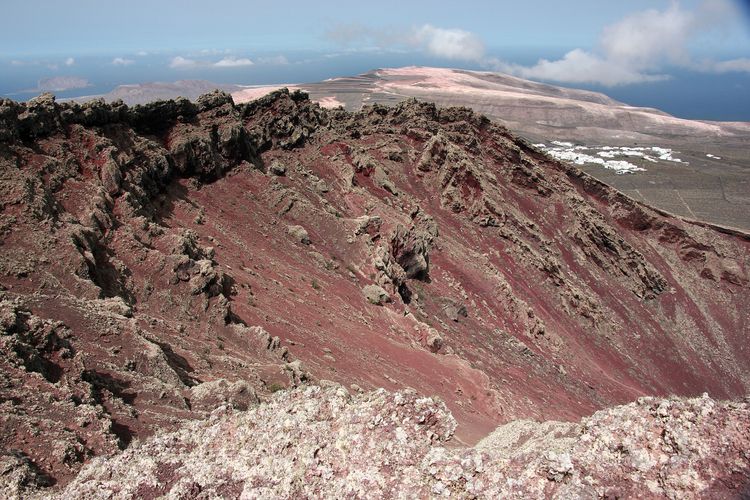
The crater of La Corona volcano.
- © VasquezLaboratorium / ShutterstockIt will soon be time to head back to Arrecife to return our van, our mobile home for these few days around Lanzarote. But before that, we make a little diversions to Famara beach. The drive itself is impressive: before reaching the beach, you feel like you're lost on the moon, and you pass through several white villages that look like they've been asleep for centuries. Along the way, you can enjoy magnificent views of the Timanfaya and La Corona volcanoes. Once there, a wild setting awaits us: the volcanic sand spit stretches for kilometres at the foot of the cliffs, while surfers ride the waves of the Atlantic.
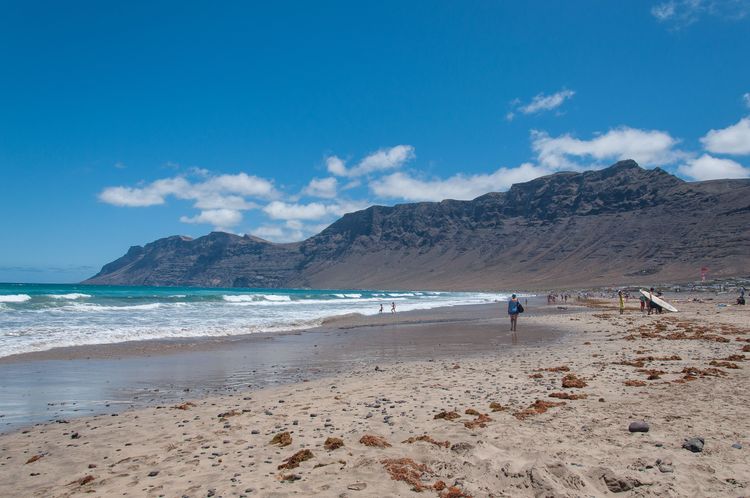
The beach of Famara à Lanzarote.
- © Gianluca Piccin / ShutterstockThat's it, it's already time to part company with our speedboat, but our stay isn't quite over yet. We've booked one last night at a great hotel in Puerto del Carmen, Lanzarote's largest seaside resort, the 5* Hotel Lava Beach. Just the thing to end our holiday on a high note! Swimming pool, beach, water sports activities, restaurants and bars... there's plenty to keep you busy on your last evening. What's more, the town is only a few minutes from the airport, so there's no risk of missing our plane tomorrow. We went to sleep with our heads full of beautiful images: beaches, volcanoes, white villages... and we knew that this wasn't a farewell to Lanzarote, but a goodbye.
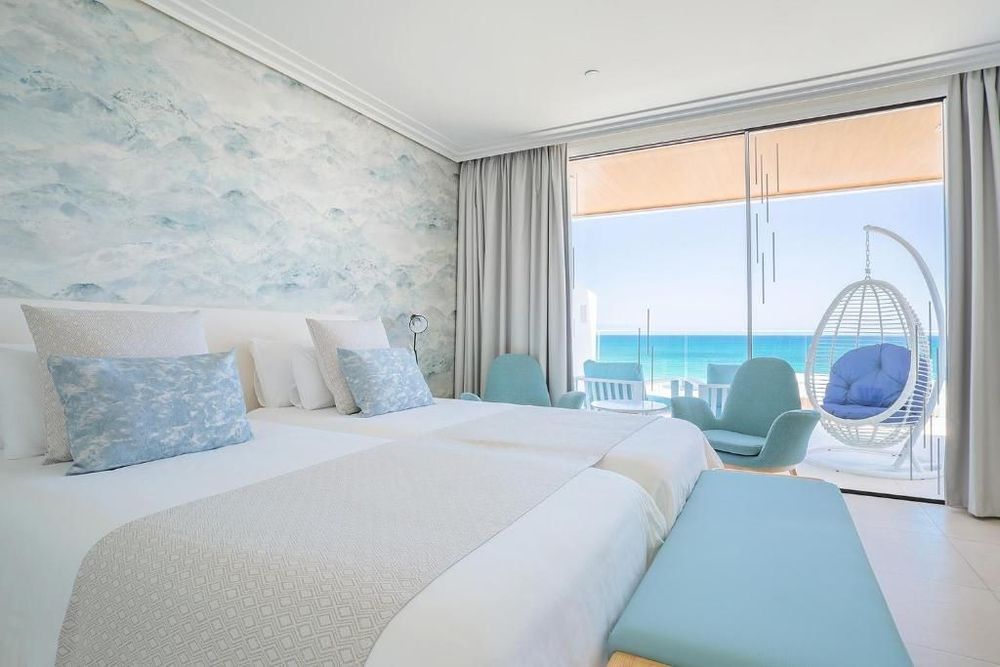 Puerto del Carmen
Puerto del Carmen
